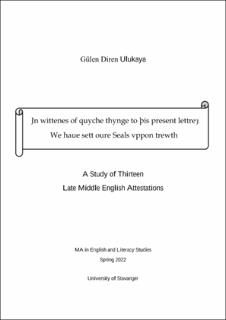| dc.description.abstract | This thesis presents an edition and study of a group of thirteen English attestations from the fifteenth and early sixteenth centuries. The texts are dated to the period 1427-1525, and will also form part of the Corpus of Middle English Local Documents (MELD) at the University of Stavanger. Each text is studied individually, and both a full diplomatic edition and a translation of the texts are provided.
The study highlights the importance of Late Middle English attestations as an early English administrative text type, written in English at a time when most administrative documents were still written in Latin or French. Furthermore, the sociolinguistic background of the texts is studied via the dates and the names of people and places they provide. The study also approaches Middle English attestations as a text type, focusing on their structure, their use of formulaic parts and their personal narratives. The texts are examined in terms of their similarities and differences, and related to the history of Late Middle English administrative documents.
The core of this study is a thorough analysis of each individual text. Starting with a physical description of the document, the analysis moves to the greeting clause and the opening formula respectively. Both the set phrases and unique components are studied. Next, the narrative part is examined, using Swales’ (2006) model of moves and steps. The relationships between the moves and steps are analysed via linking words with the help of Fludernik’s (2008) model of discourse markers. Finally, the closing formulae and dating clauses are examined and the variation found is related to the sociohistorical context of the texts.
The study argues that attestations are not made up of only formulaic parts; their language and textual structure, as well as their contents, are highly variable. In particular, the narrative parts may contain colloquial language representing the voices of the attestators. Additionally, even the formulaic parts vary greatly, illustrating the great amount of variation in the Middle English period. | |
